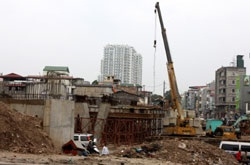More innovation in the Government\'s thinking on public investment has been called for to restructure and increase efficiency of public projects.
 |
| The major Van Cao-HoTay project, approved in 2007, has yet to be completed due to slow land clearance. |
Economic experts yesterday agreed that a restructuring of public investment was urgently needed, at a workshop co-organised by the Ministry of Investment and Planning and the United Nations Development Programme in Hanoi.
Public investment during the last 10 years was labelled inefficient, and had created an imbalanced economy as well as raising risks of macro-economic instability, vice president of the Vietnam Economics Association Nguyen Quang Thai said.
Nguyen Duc Thanh from the National University of Hanoi\'s Centre for Economic and Policy Research said the inefficiency of public investment also resulted in a recent increase of public debt, which was nearly 57 percent of GDP last year and is estimated to see a 2 percent increase this year due to rising inflation.
Inefficiency
Deputy general secretary of the Vietnam Economics Association Vu Tuan Anh said each year the Government had spent a third of the State budget on public investment since 2000, which is seen as the highest among countries in the East and Southeast Asia.
The GDP growth rate has remained lower than the investment growth rate, proving that investment has been inefficient, he said.
"Public investment failed to encourage and promote the development of key economic sectors," Anh emphasised, reasoning that no economic breakthrough had been made and the investment structure seemed to remain unchanged during the last 10 years.
The country\'s Incremental Capital-Output Ratio (ICOR) index during 2000-2007, which was the ratio of additional output to new investment, also revealed that public investment rated the least efficient compared with private and foreign-backed sectors.
He pointed out that State-owned enterprises (SOEs), though occupying up to about 40 percent of the total investment of all enterprises, created only 25 percent of the total pre-tax turnover and 19 percent of employment, while losses has also been revealed in some SOEs such as Vinashin.
Haphazard investment and an over-estimation of real demand were seen as the root causes for the low efficiency of public investment, according to deputy director of the ministry\'s Department of Finance and Monetary Affairs Phan Thanh Ha.
Agreeing with these findings, Anh added that hundreds of construction projects, including seaports, airports and industrial zones remained unfinished, which restricted further economic growth. Many projects that had been approved had not complied with the country\'s socio-economic master plan which had further created inefficiency, he said.
Recommendations
Thai emphasised that public investment should be restructured towards improving the quality of life and social welfare for residents, and that "prior consideration should be put on macro-economic stability."
Currently, 75 percent of public investment was spent in developing the economy, especially infrastructure development, while the rest was for social affairs and State management.
In the next 10 years, the share of public investment for social affairs should be increased to at least 30 percent.
Reducing public investment would work alongside increases in private investment, focusing on key economic sectors and leaving non-state-owned enterprises to join other sectors would improve the situation, Thai said.
The encouragement of investment schemes such as public-private partnerships (PPP) and build-operate-transfers (BOT) would also help reduce the amount of public investment.
The reduction of corporate income tax should also be put into consideration to raise the competitiveness of private and foreign-invested enterprises, encouraging them to invest more, he added.

Leave your comment on this story